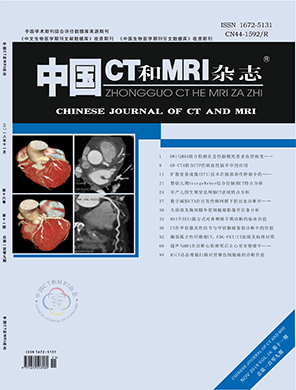摘要
目的分析急性脑出血与脑梗死 患者MRI影像学特征及其诊断价值。方法 选取2017年2月-2018年4月期间我院急诊 科诊治的首发急性脑出血患者60例与急性 脑梗死患者60例,分别为脑出血组、脑梗 死组。均接受MRI检查,临床各项资料完 善,影像学资料清晰。分析病灶的MRI影 像学特征,包括位置分布、形状、病灶信 号特征及周围水肿带分布情况等,并进行 χ2 检验。结果 脑出血组病灶部位以基底 节区(78.33%)为主,形状分布以类圆形、 楔形、点状形(88.33%)为主,脑梗死组则 以小脑、顶额、颞叶区(85.00%)和不规则 形(76.67%)为主,两组病灶的分布、形态 特征比较有统计学意义(P<0.05)。脑出 血组病灶T1WI、T2WI、DWI信号特征分别 以等信号(91.67%)、低信号(71.67%)、混 杂信号(70.00%)为主,脑梗死组则分别以 低信号(71.67%)、稍高信号(65.00%)、高 信号(86.67%)为主,差异有统计学意义(P <0.05);两组T2 Flair信号特征差异无 统计学意义(P>0.05);脑出血组、脑梗 死组病灶周围DWI高信号水肿带的发生率 (80.33% vs 30.00%)比较有统计学意义(P <0.05)。结论 急性脑出血与脑梗死患者 MRI影像学特征(病灶部位、形状、信号特 征及周围水肿带分布)具有明显差异,这 对提高二者的临床诊断率有重要价值。
Objective To analyze the MRI findings of patients with acute cerebral hemorrhage and cerebral infarction and their diagnostic value. Methods A total of sixty patients with acute cerebral hemorrhage and 60 patients with acute cerebral infarction were selected from the emergency department of our hospital from February 2017 to April 2018. And they were included into the cerebral hemorrhage group and cerebral infarction group, respectively. All patients underwent MRI examination, all clinical data were complete and imaging data were clear. The MRI findings of lesions were analyzed, including the location, shape, signal and distribution of surrounding edema zones. The χ2 test was performed. Results In the cerebral hemorrhage group, the basal ganglia region (78.33%) was the main location of lesions, and the shape of distribution was mainly round, wedge-shaped and punctate (88.33%).. In the cerebral infarction group, the cerebellum, parietal frontal and temporal lobes (85.00%) were mainly distributed, mainly irregular (76.67%). There were statistically significant differences in the distribution and morphological features of lesions between the two groups (P<0.05). Signals on T1WI, T2WI and DWI in cerebral hemorrhage group mainly were equal signal (91.67%), low signal (71.67%) and mixed signal (70.00%), while those in cerebral infarction group were low signal (71.67%), high signal (65.00%) and high signal (86.67%), respectively (P<0.05). There was no significant difference in T2 Flair signal between the two groups (P>0.05). There was a statistically significant difference in the incidence of DWI hyperintensity edema zone around lesions between the two groups (80.33% vs 30.00%) (P<0.05). Conclusion There are significant differences in MRI findings (location, shape, signal and distribution of surrounding edema zone) between patients with acute cerebral hemorrhage and cerebral infarction, which is of great value for improving the clinical diagnosis rate of both diseases.
【关键词】急性脑出血;急性脑梗死; MRI;特征;诊断
【中图分类号】R445.2
【文献标识码】A
【DOI】10.3969/j.issn.1672-5131.2018.11.002
前言
急性脑出血与脑梗死均为临床常见的急性脑血管病,均具有发病 突然、进展快、致残率与致死率高的特点,二者具有共同的脑血管病 基础,如血压、血脂代谢异常、凝血纤溶功能变化、动脉粥样硬化 等,且临床症状、体征极为相似,因此,临床上此类患者极易因误诊 而贻误最佳治疗时机,而及时作出准确诊断对尽早开展针对性治疗及 改善预后至关重要[1-2]。传统影像学检查诊断中,急性脑梗死更倾向于 选择MRI检查,而对急性脑出血的MRI诊断,尤其是超急性脑出血的MRI 诊断信心不足,多以CT检查结果为准,导致临床上对此类患者的诊断 需先后接受MRI、CT双重检查,不仅可能耽误最佳治疗时间,影响患者 预后,还增加了医疗检查费用[3]。为此,本研究重点分析MRI对急性脑 出血与脑梗死的鉴别诊断价值,以期进一步积累MRI诊断经验和减少的 临床不必要的检查。
中国CT和MRI杂志
第16卷, 第 11 期
2018年11月

相关文章